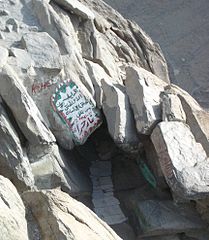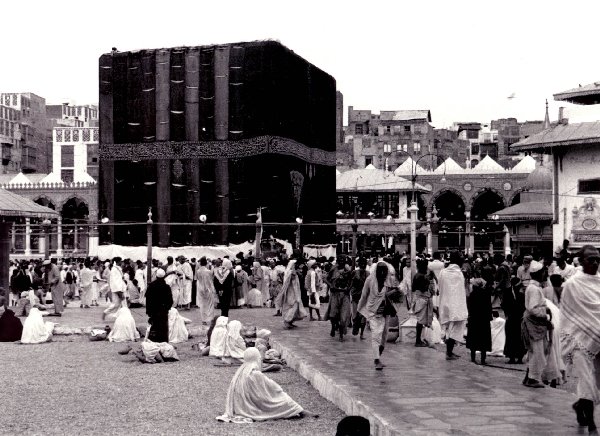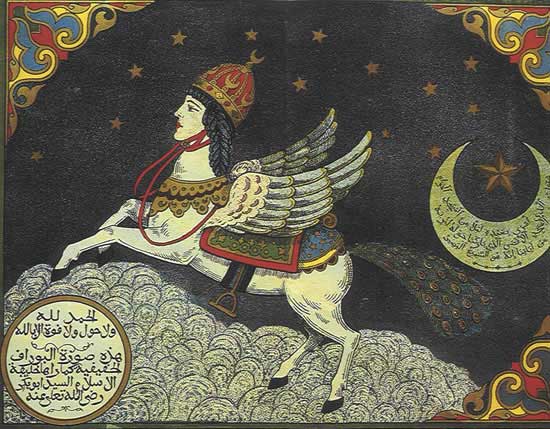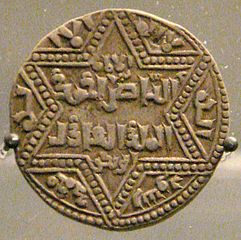

Islam and Muhammed
Muhammad (Abū l-Qāsim Muḥammad b. ʿAbd Allāh b. ʿAbd al-Muṭṭalib b. Hāšim b. ʿAbd Manāf al-Qurašī;), the founder of the Islamic religion, was born about 570 in Mecca and died 632 in Medina.
In the modern versions of the Qur'an, whose history should be seen, in Sura 33, verse 40, he is called 'the seal of the prophets', which is for example by the followers of the Shia falsely interpreted as the last of all the prophets sent by Allah - with the exception of the Imam Mahi. Another title is Prince of Creation (seyyid-un-ka'inat). Sura 47 also deals about him.
The Sira of Ibn Ishaq († 757) is the oldest work about the life of Muhammad, which is preserved only in a later edition by Ibn Hisham († 834).
Muḥammad's life (official version)
Muhammads father Abd Allah ibn Abd al-Muttalib died before Muhammad was born. His mother Aminah died when he was six. The orphan was consigned to the care of his grandfather, the head of the clan of Hashim. After the death of his grandfather Muhammad was raised by his uncle Abu Talib.
Mohammed worked in his youth as a shepherd. He became a member of the Quraisch tribe, the leading clan in Mecca. Mohammed then moved into the household of the younger brother of his father, who worked as a dealer. During a travel with his uncle to syria Mohammed is said (unsafe) to have met the christian monk Bahera.
Around 595, his former employer, the merchant widow Chadidscha bint Chuwailid from the tribe of the Quraish, offered him marriage, whereby Mohammed obtained financial independence and social security. From her he had his daughter Fatima.
After her death, he is said to have married 12 other women, who are called mothers of the faithful (umm-ul-muminin).
Already in Mohammed's lifetime the so-called Ahl as-Suffa ('people of the shadow-roof') grouped around him in Medina, living in forced or voluntary poverty.
Mohammed used to spend annually a month on the mountain Hira near Mecca for the  purpose of penance and meditation. By 610 the archangel Gabriel (Jibril, Jibril) is said to have appeared in his dream, and he is said to have received his first revelation in the cave.
purpose of penance and meditation. By 610 the archangel Gabriel (Jibril, Jibril) is said to have appeared in his dream, and he is said to have received his first revelation in the cave.
The revelation came at a time when Muhammad sought solitude. He received the first part of holy Qu'ran, according to his account of the angel Gabriel,(who had before appeared to the virgin Mary...), and at first Muhammad experienced great pain and was afraid to die.
Muhammad was then instructed to recite the name of Allah, as the beginning of Sura 96, verses 1-5 says: Carry before in the name of your Lord, who created man from a clump of blood! Because your Lord is unsurpassed in the good, who brought near by the writing-tube und taught man what he did not know! "
After this first revelation, no new revelations came for a time. Then they came back and forth for the rest of his life. The revelations changed their style during the 22 years from more poetic to more prosaic, and also in terms of content, with warnings about what would happen if humanity did not adapt itself to the will of God in its rules and rules of behavior.
622 Mohammed escaped to Medina, as he had found out, that the tribe of Qoreish planned to kill him. 630 he came back to conquer Mecca.
The Beleife
The Koran (al-qur'ān, the reading, recitation), the after his death compiled (and after that 3 times revised and changed by 3 caliphs) sacred book of Islam, includes 114 suras (chapters). It is written in a rhyme prose (Arabic : Sadsch) and refers in many passages to own other passages.
The Quran contains, however, a lot of strange expressions that make the position of the 'sole prophet of Allah' wiggl. The presentation-style of the contents is abundantly coarse. It contains rules for a tribe-society of the middle ages and can hardly lead the believer without practical Sadhana on a path to Allah, as far as Allah wants him at all in heaven...
* The five pillars (Arkan, Pillows) of the faith are particularly emphasized there:- The confession of faith with confession to Allah as the sole God (Schahada, Tašahhud)
- The compulsory prayer (Salat) - daily five times in ritual purity
- To do charity - for the poor and for people who have been in distress because of their faith
- The fasting(Saum)
- The Pilgrimage to Mecca (Hadsch)
* The essential beliefs are listed in Sura 2, verse 285:
- The faith in God
- in his angels
- in his books
- in his prophets
- to the life of the beyond
- to the predestination, whether good or bad

Mohammed even succeeded in transforming the Kaaba (Sura 3, verses 96-97) in Mekka into a islamic sanctuary, which was according to Islamic false representation in Sura 22/26 built by Adam. It was previously used as the sanctuary of the local deity Hubal of the Jāhilīya.
Today's Kaaba is a new building from the 14th century. The visit of the Kaaba and the temporary meeting consolidates the Islamic community. It does not, however, lead to the spiritual development, which is necessary for the entering into a paradise, for which, among many other things, a transformation of vitality is necessary.
The unskilled sexuality is also nowadays (it re-appeared during some demonstrations - the Taliban have their own dominant sight...) in the Orient an unsolved problem. At the time of Mohammed, a decadent caliphism ruled with harems(probably therefore the promises of huris in paradise). In Islam, despite the prohibitions, sexuality is seldom understood as 'coming from Satan'. Nowadays this is the reason of growing overpopulation and its problems.
The explosion of population in Iran, Pakistan and Bangladesh, where 100 million people live on a territory as big as Ireland, and in Africa, speaks for itself. In Tibet and China, large-scale forests were cut down and more grazing was carried out around the Himalya, resulting in less rainfall in the neighboring areas, which also has a negative impact on the southern Sahara where the Passat - wind became still stronger.
Today the Shiites, the followers of the Shia, regard Alīib Abī Tālib, the son-in-law and cousin of the Prophet Mohammed, as his successor (Caliph) and Imam, whom he designatet, and they claim the general succession, which testifies to a stone age religious understanding, in which religion is inherited through genes - without a real spirituality in the background of the succession. The logical result is an alienated religion of unsuitable followers.
The larger group of the Sunnis represents a branch of Islam, which originates from the caliphate founded by Abu Bakr. Behind the rivalries between the groupings, hides not only a lacking of education and position fights, and nowadays also financial problems, which are caused by wars and economic development and population development. Today some Islamic countries, especially for tourism, are trying to promote the visit of Mecca.
A well-known argument here is that when Shiites and Sunnis ask for the blessing of Allah, for whom should Allah choose?
Inner mystic Islam
Just like other world religions, Islam, which was soon frozen in outward rituals and rules, initially had its secret inner practice systems (for soulfully mature initiates).
Spirituality survived and developed later parallel to the official Islam in the Sufism, which was little desired and counteracted. In addition, some gnostic groupings of the Shia, such as the Ismailites, the Alevis, the Nusairiers and the Druze, also emerged.
"The day will surely come when you will see faithful men and women, the true believers who are advancing forward, with a light that comes before them, and the lights in their right hands." A voice will tell them, "Rejoice good news: Today you will enter the gardens of the flowing streams where you will live forever, which will be the highest triumph. " (-Qur'an, Al-Hadid, Surah 57:12-);
This could be a reference to lost spiritual exercises, which include the well - known exercises of the albanian - turkish Sufi - Bektashi dervishes, which were hidden in the Koran (...; alam; ...; na). However, they are only suitable for advanced students of step 12 of the Universal Path [2]. Freiherr von Sebottendorf, the founder of the inglorious german Thule Order, who was murdered in Istanbul in 1945, brought them to West-Europe, where he published them in Germany.
Also, exercises are known, in which the student draws a circle around him in the sand. Then he spreads the fingers of the right hand and places the handplate on the right ear and meditates on the "silence" of the right ear (Awaz-i-Mustqim) , which is already in the direction of Sufism.
Muhammeds ascension
Muhammad's Ascension (Mi'rādsch) to heaven has three traditions or lores:
- Ascension from a place in the Kaaba Shrine in Mecca over a ladder into the heaven.
- Ascension as described in "The Bokhari" (Vol.15, S. 3615) where Mohammed was riding with a "White Horse" to the "holy mountain" at Allah(Sura 17: 1), where he met the 10 prophets, and then returned. [4]
- Combination of the coranic journey to Jerusalem (bait al-maqdis) with subsequent ascension (mi'rādsch) from Jerusalem. It can be found with content variants in Hadith, in the Koran-exeese, in Islamic historiography and in the Prophet legends(Qiṣaṣ al-anbiyāʾ).
This ride would be no more than a description of step 14 of the Universal Path: the sacred mountain is from the esoteric standpoint to be equated with mount Sinai or mount Zion of the Bible, the first ascension into the Divine and the beginning of the Samadhi - stages.

The mystical horse buraf
- A heavenly ladder was first described in of the Egyptian Book of the Dead, which was under the care of the sun god Re and belonged to Osiris.
- Jacob sees in a dream vision according to Genesis 28:11, during his flight from Esau from Be'er Sheva to Harran, a heavenly ladder (Hebr. Sullam), which stands on the earth and whose extends point to heaven. On it he sees the angels ascending and descending (Gen 28:12), and above is the Lord (YHWH).
- Otherwise a Jacob's ladder of the Evangelist John (John 1.51) is known.
Mohammed's alleged vision in Jerusalem concludes Jewish-Mosaic influences, and the clever mention of Jerusalem led to this being the third Islamic main sanctuary, and the influx of Islam expanded northwards as desired ...
In the jewish Merkaba literature, much earlier than Islam, just as above ladders, similar and much higher heavenly voyages (eg. Enoch a.o.) are described. Did Mohammed leane at here, or did he have contacts to initiated jews in medina ?
On the other hand, both Islam and the Jews refer to Abraham. Jesus, whose crucifixion in Islam is not universally acknowledged (Sura 4: 157), said to the Pharisees wo fasted, and kept the 10 commandments for show, that their father is not Abraham but the Satan (since the spiritual development was completely lacking, which, of course, can not be attained by observing commandments and fasting alone, but only by the development of the spiritual soul.) The "holy people" of God are inwardly sanctified, transfigured and spiritually developed, independent of the religion concerned.
The Jihad
Islam had several wars since its beginnings. It received a bad reputation as violent through the misunderstanding of the jihad et al. , not only because of Al-Qaeda and ISS, but also because of past warships to India and the former piracy in the Mediterranean sea.
The sufi Al-Ghazali gave the Jihad a new additional meaning: Not only was the battle on the battlefield jihad, but also the struggle against one's own lower ego (an-nafs al-ammara). In Sufism the 'great jihad' has the meaning of an extensive purification on the path : Whoever fights (jaahada), he fights only for his own self" (Q 29: 6). The "Jihad" serves the "defense against the enemies and the devil" (the one on the Tarotcard 15, this also corresponds to the path of the warrior in Hinduism).
The true holy war (jihadun-nafs) with the option of "entering paradise" is in fact the long path of the step 15 of the Universal path (including, for example, the fight for ones own truth and justice).
In past secularly "holy wars", the leaders of a secular Islam abused the intolerance and the fanaticism of undeveloped and good faith believers - Allah became an alibi supplier (comparable to the Christian crusades but still worse).
Dschanna (adn) - the islamic paradise
The Islamic paradise is divided into up to 8 levels, with the highest levels intended for the most devout. On the other hand, there is talk of virgins in paradise who surround the martyrs of jihad.
Worldly promises such as "with 72 (or 7) virgins in paradise" ( ka'ib in Quran 78:33 as "with swelling breasts ) speak for themselves" and touch specific desires of spiritually undeveloped contemporaries (for some sincere seekers a reason to reincarnate elsewhere...). They may also be a Sandhabhasa - allegory to the developed Pingala-snake-forces - such woman with rounded breasts are also common in the iconography of Ishtar (Lilitu) and of godesses of the minoic religion and in tantric scriptures.
In Koran 44:52 there is also: 'There are girls with a chaste look which neither men nor jinn touched before them' , and 52:20, respectively : They are leaned on a row of resting cushions. And we will marry her with beautiful, big-eyed girls. In paradise are virgins and not wenches for lazy uncivilized 'Muslims' (like the Taliban and others, for which Allah has an alibi function for their status in society) , who in Afghanistan make a 14-head large family without foundation of existence and who live sometimes from the drug market and give nothing on the later problems of the many children - just as on the problems of the drug users...
The 10 Imams
Twelve Imams are, according to the Athnā'ashariyyah branch of Shia-Islam and Alevi-Islam, the only legitimate successors of the Prophet Mohammed, and thus pure guardians of his message - ignoring the changes of the Quran made by 3 caliphs.
The 12th was Imam Madhi al-Muntathar (born in 869 AD), who did nothing, and is still to live in secrecy and will (allegedly) appear before the end of the world, because otherwise the elitist belief system would wobble....
A true IMAM (priest) has gone the long path and accomplished step 16 of the universal path. He is not only a skillful emotional preacher with human feelings and intellectual logic and human interests. But how could such a person arise from the rigid Islam?
In a similar way, Hinduism also distinguishes between a Brahmin, who teaches only, and a Brahmin who is rooted in Brahman. This beleife comes probably from Avesta (Yast 19:89) where Soshyos will come on a white horse in a whirl of fire.
Allah - the One
An essential Quran - doctrine is "There is only one God, and that is ALLAH".
A common Kalma is "There is no God but Allah, and Muhammad is His messenger," which is separately in the Qur'an in 3: 2 "There is no God but Allah" and elsewhere in 48:29 with "Muhammad is Ambassador of Allah" is occupied.
But since the size of the universe of over 25 billion lightyears is known, this beleife must be relativized.
Allah would have much to do, if He would be a teacher of progressed holy men in the huge universe. This 'only One Allah' - was was a planetary belief, which was adapted to people's receptive capacity. To these 'god' revealed himself (not only - if at all) to Mohammed through his angels, though there must be a suspicion that his quotations and dictations contain also religious knowledge of the past, which was occupied and transferred in some groups of initiates.
Muhammad's consciousness was much too planetary to judge or understand this. He had certainly never heard of the cosmos and other higher divine hierarchies, like in the heavens of the sun and in the galaxies.
A more universal monistic view would be: On our planet there is only one planetary LOGOS, because in the highest divine everything is in unity: Allah is with his revelation angels is the Creator God (residing here as Jah Jahwe Zebaoth or as the Indian Ishvara). The nature of his revelations, however, speaks against Mohammed.
 The official Islam sees itself as a revelation religion, and the mediated knowledge about Allah, his four angels, about the 10 prophets and the names of Allah fit seamlessly in the spiritual tradition.
The official Islam sees itself as a revelation religion, and the mediated knowledge about Allah, his four angels, about the 10 prophets and the names of Allah fit seamlessly in the spiritual tradition.
In the Book of Job and in the opening of the Bible, similar things are conveyed. The love of God, which was later equated with Jesus 'altuism' and charity, is found at first in the Old Testament.
The Madhi
A part of Islam expects unofficially (Hadiths) the last IMAM, the Madhi, the guide of the path, who is also depicted as a rider on a horse with long spear, but is not directly mentioned in the Koran.
The belief in the Madhi as the sole second prophet of Islam is a presumption, which is to expose the superiority of Islam again. This teaching with the representation of the Madhi as a rider on a horse probably descended from the iranic Zend Avesta and was simply collected and redesigned for Islam.
Here the expectations go wild, because the self-realization and the clairvoyance are missing and group interests are predominant.
The appearance of the Madhi has two phases:
1. Appearance at a time with material and spiritual problems
2. Reappearance at the beginning of the Golden Age - after a time of devastation and confusion, then a world judgment and a paradisiacal age of peace.
Naturally has Islam the one-sided expectation that this limited religion will then be the world religion. However, the planetary religion of a spiritual age must be much more enlightened, comprehensive and internalized with exercises better than in Sufism and the like.
A look at the fragmented divisive groups, which are related to Muhammad's relatives (just as formerly in Ireland between the Catholics and Protestants), which of course did not understand the inner religion and mostly reject exercises, can only confirm this view.
In the much older Zoroastrian religion, the world-solver Sosiosh (Zend) or Soshyos (Persian) comes similarly on a white horse, wrapped in a whirl of fire [Avesta (Yast 19:89)]. The indian Kalki rides similarly on a horse.
Sufism and the realisation of god
Sufism is unofficially often counted among Islam, whose masters became popular in the West. Many Sufiorders, however, dissociate themselves from official Islam, where Sufism is little regarded and also fiercely combated.
A Sufi is also often described as someone who has turned away from the world and takes the path to Allah. Therefore every Arab country has its own Sufimaster.
The visions of God, about which Sufis report, are classified as secondary by official Islam, and only the vision of Mohammed is accepted as "the Vision", but actually the critics cannot judge this lacking own visions(Surah 70, 1-4) and have probably never heard about jewish merkaba.
Visions and Spirituality
In spiritual yoga, most visions are viewed as unimportant.
The illuminating phase begins here first after the visions are extinguished.
This also enlightens the spiritual height of Mohammeds sadhana.
Compared with Sufi - masters like Rumi and Kabir, with their realization of God, Mohammed was merely a small light.
However, anyone who has ever known a fundamentalist Islamic hardliner(or mule) without inner spiritual development and experiences, who hides behind his religion because he was educated or for reasons of adaptation of a community, or for reasons of advantage such as remedies for power, or perhaps only because fear of religion, understands the context and does not attempt any reforms. This is also a problem with other western religions.
Literature
- Letters from a Sufi Teacher - Shaikh Sharfuddin Maneri
- Die geheimen Übungen der türkischen Freimaurer, Rudolf von Sebottendorf, Waltharius | ISBN: 9783932928123 (evtl. also in the web as free PDF - Mr. Sebottendorf died 1945)
- Secret Practices of the Sufi Freemasons: The Islamic Teachings at the Heart of Alchemy, Rudolf von Sebottendorf, Stephen E. Flowers, Runa-Raven Press 2011, ISBN-10: 1885972148, ISBN-13: 978-1885972149
- Wiki about the names of Allah
- 99 names of Allah
- Muhammed - his life - based on the earliest sources , M. Ling
- [4] Wiki about Mohammeds ascend to heaven
- Wiki about the Alevism
- The buraq worshipped by 'two princes'
- Islamic Sadhana !
- Religion and generalised trust , Handi Hadiwitanto, S.58-59
- The stories of the prophets - by Ibn Kathir
- Guillaume, Alfred: The Life of Muhammad, Oxford: Oxford Universitiy Press, 1998
- Jeffery, A - The Quest of the Historical Muhammad , 1926 (in the web as pdf)
Weblinks
|
|
of Spirituality
universal-path.org